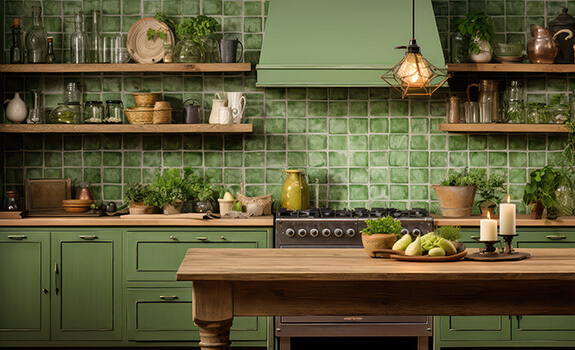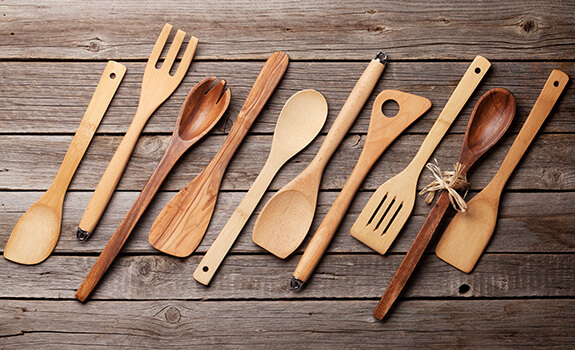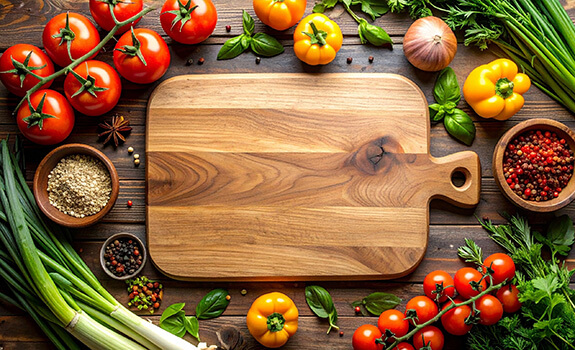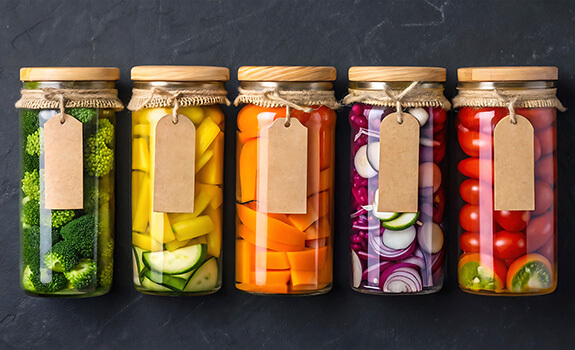August 15, 2025
Creating a Toxin-Free Kitchen

By Julie Gregory, Chief Health Liaison for Apollo Health
Creating a toxin-free kitchen isn’t just about keeping things clean — it’s about protecting your health at the source. From the cookware you use to the products you store your food in, hidden chemicals can quietly leach into your meals and disrupt your hormones, immunity, and brain function over time. In this guide, we’ll explore simple, science-backed steps to detox your kitchen space, reduce your exposure to harmful substances, and create a healthier environment for you and your family — starting right where it matters most: the heart of your home.
Cookware
We all know to avoid nonstick cookware made with PFAS — including Teflon —because these coatings can release toxic fumes when overheated and leach harmful “forever chemicals” into your food if the surface gets scratched. Other cookware to steer clear of includes cheap ceramic-coated pans, which may contain heavy metals or PFAS unless made by a trusted brand, and aluminum pans, which are highly reactive and can leach into acidic foods like tomato sauce or citrus-based dishes.
If you’re ready to upgrade your kitchen, see the safest cookware options below that won’t leach toxins into your food — and will stand the test of time. For additional choices and to learn the safest cooking methods, Apollo Health members can check out Hidden Toxins in Cooking Techniques and Cookware.
- Cast Iron
- Pros: Naturally nonstick with use, adds a small amount of iron to food, and is extremely durable
- Use for: All temperature cooking, stovetop, and oven
- Watch out for: Rust if not dried properly, and avoid acidic foods for long cook times
- Cons: Needs to be seasoned and not recommended for those with elevated levels of iron, as small amounts will leach into your food
- Recommended brands: Lodge, FINEX
- Enameled Cast Iron
- Pros: No need to season, non-reactive, excellent for slow cooking
- Use for: All temperature cooking, stovetop, and oven
- Avoid: Cheap enamel that may chip — stick with reputable brands
- Recommended brands: Le Creuset, Staub
- Stainless Steel
- Pros: Non-reactive, durable, safe at high heat
- Use for: All temperature cooking, stovetop, and oven
- Tip: Use oil or broth to prevent sticking; look for surgical-grade (18/10) stainless steel
- Recommended brands: All Clad D3 Stainless, AVACRAFT 18/10
- 100% Ceramic
- Pros: Completely inert and free from heavy metals and PFAS
- Use for: All temperature cooking, stovetop, and oven
- Cons: Can be heavy and fragile if dropped
- Recommended brand: Xtrema
- Glass (Oven-Safe)
- Pros: Non-toxic, non-reactive, doesn’t leach
- Use for: Baking, microwaving, food storage
- Avoid: Sudden temperature changes that could cause breakage
- Recommended brands: Pyrex, Anchor Hocking
- Carbon Steel
- Pros: Lightweight alternative to cast iron, naturally nonstick with seasoning
- Use for: All temperature cooking, stovetop, and oven
- Note: Requires maintenance like cast iron
- Recommended brands: Made In, De Buyer
Cooking Utensils

Just like cookware, the utensils you use can impact your health. Many plastic and even silicone tools can leach chemicals when exposed to heat, while metal utensils may scratch nonstick surfaces and release unwanted particles. Choosing safe, non-toxic utensils — like those made from stainless steel or wood helps protect both your food and your cookware.
- Solid Wood Utensils (Untreated / Natural)
- Look for: 100% hardwood (e.g., olive wood, beechwood, teak, maple) with no glues, stains, or finishes.
- Avoid: Composite or laminated wood, which may contain formaldehyde-based adhesives.
- Best for: Cast iron, enameled cast iron, stainless steel, ceramic, glass, and carbon steel cookware, stirring thick foods, and serving hot or cold dishes
- Recommended brands: Earlywood, Jonathan’s Spoons
- Bamboo Utensils (Single-Piece, Organic)
- Look for: Certified organic, single-piece construction.
- Avoid: Bamboo utensils made with binding resins or glues (common in cheap sets). Not for use with high heat.
- Best for: Enameled cast iron, ceramic, glass, tossing and serving salads, mixing dry ingredients
- Recommended brand: Bambu ‘Give it a Rest’
- Stainless Steel Utensils
- Look for: 100% food-grade stainless steel (304 or 18/10).
- Durable, non-reactive, and safe for high heat.
- Best for: Mixing, flipping, whisking, and serving with cast iron, stainless, glass, and carbon steel cookware
- Recommended brands: All‑Clad Stainless Steel Utensils, ReNea Stainless Steel Utensils
Cutting Boards

Cutting boards may seem harmless, but they can be a hidden source of toxins in the kitchen. New research is raising concerns about plastic boards shedding microplastics, as well as glues and chemicals found in many composite wood or cheaper bamboo boards. As scientific understanding evolves, so do the recommendations— what was once considered safe may no longer be ideal. Choosing toxin-free cutting boards is a smart way to reduce your exposure and protect the integrity of your food prep.
- Solid Hardwood Cutting Boards (No Glue or Synthetic Finish) Materials: Maple, walnut, beech, cherry, or teak.
- Why it’s safe: Made from a single block of wood — no glues, finishes, or chemicals.
- Look for: Boards treated only with food-grade mineral oil or beeswax.
- Best for: Use exclusively for vegetables and fruits
- Follow care instructions below*
- Recommended brands: Earlywood, John Boos (R-Board series), Jonathan’s Spoons.
- Cons:
- Requires regular (monthly) oiling to prevent cracking. Best oils include food-grade mineral oil, fractionated coconut oils (RBD), or beeswax + mineral oil or coconut oil blends.
- Not dishwasher safe
- Bamboo Boards (Single-Piece, Organic)
- Why it’s safe: Can be a good option if truly glue-free and organic.
- Look for: Certified organic, formaldehyde-free, single-piece bamboo.
- Best for: Use exclusively for vegetables and fruits
- Follow care instructions below*
- Recommended brands: Bambu (Undercut Series, certified organic), Greener Chef Bamboo Cutting Board
- Cons:
- Many bamboo boards are glued together with toxic adhesives — choose carefully
- Less durable than hardwood
- Requires regular (monthly) oiling to prevent cracking. Best oils include food-grade mineral oil, fractionated coconut oils (RBD), or beeswax + mineral oil or coconut oil blends.
- Not dishwasher safe
- *Care instructions for solid wood and bamboo cutting boards: Wash by hand with warm water and mild soap immediately after use. Wipe dry with a clean towel — never let it air dry wet, and don’t soak it in water. Deep clean weekly by sprinkling coarse salt or baking soda over the surface, then scrubbing with half a lemon or a clean, damp cloth. Rinse lightly and dry immediately.
- Glass Cutting Boards
- Why it’s safe: Non-porous, inert, won’t leach or absorb anything
- Best for: Raw seafood, meat, poultry, or other tasks where sanitation is critical
- Recommended brands: Mymonfif, Murrey Home
- Cons:
- Can dull knives quickly
- A slippery surface may affect control
- Heavy and breakable
- Stainless Steel Cutting Boards
- Why it’s safe: Durable, non-toxic, and easy to disinfect
- Best for: Raw seafood, meat, poultry, or other tasks where sanitation is critical
- Recommended brands: SNOWCLAD, Stron
- Cons:
- Can dull knives
- Not ideal for precise cutting or everyday chopping
- Heavier than titanium
- More prone to cosmetic cut marks than titanium
- Titanium Cutting Boards
- Why it’s safe: Durable, non-toxic, and easy to disinfect
- Best for: Raw seafood, meat, poultry, or other tasks where sanitation is critical
- Recommended brands: Taima®, Siraat® Titanium Cutting Board V1
- Cons:
- Can dull knives (despite claims to the contrary)
- A slick surface can reduce control during cutting
- More expensive
Food Storage

Food storage is one of the easiest places for hidden toxins to sneak into your kitchen. Plastics can leach hormone-disrupting chemicals like BPA, phthalates, and even microplastics — especially when exposed to heat, acidic foods, or prolonged storage. Even “BPA-free” plastics often contain equally harmful substitutes like BPS. Silicone, while often marketed as safe, can also degrade over time and leach chemicals under high heat or with oily foods. Aluminum containers and foil are also a concern, especially with acidic or salty foods, as they can leach metal into your meals. Fortunately, safer alternatives are readily available. By switching to toxin-free food storage containers, you can protect your food, reduce chemical exposure, and support a cleaner, healthier kitchen environment. See below for safe and sustainable storage ideas.
- Glass Containers with Glass or Stainless Steel Lids
- Why it’s safe: Inert, non-leaching, and safe for hot, acidic, or oily foods
- Best for: Leftovers, meal prep, freezer storage, reheating
- Recommended brands:
- Anchor Hocking (all-glass options)
- Wean Green (tempered glass with BPA-free lids, some models all-glass)
- Life Without Plastic (glass containers with metal or bamboo lids)
- Stainless Steel Containers
- Why it’s safe: Durable, inert, and plastic-free
- Best for: Snacks, lunches, dry goods, fridge, and freezer use
- Recommended brands:
- Onyx
- LunchBots
- ECOlunchbox (offers nesting tins and bento-style)
- Beeswax Wraps
- Why it’s safe: Made from organic cotton infused with beeswax, tree resin, and jojoba oil
- Best for: Keto wraps or sandwiches, cheese, veggies, fruits, and covering bowls
- Reusable and compostable
- Recommended brands:
- Bee’s Wrap
- Abeego
- Unbleached Paper or Parchment Bags
- Why it’s safe: No plastic coatings, bleaches, or dyes (look for certified compostable options)
- Best for: Dry snacks, short-term fridge storage, baked keto goods
- Recommended brands:
- If You Care
- Lunchskins (paper line)
- Cloth Bags (Cotton, Linen, or Hemp)
- Why it’s safe: Natural fibers, especially when organic and unbleached
- Best for: Keto bread or wraps, produce, pantry storage, travel bags for supplements
- Recommended brands:
- Vejibag (for produce)
- Simple Ecology
- EcoRoots
Transforming your kitchen into a toxin-free space doesn’t have to happen overnight — and it doesn’t have to break the bank. While some of the safest cookware, utensils, and storage options can be more expensive upfront, you can make gradual changes over time. Start by replacing the most worn or questionable items first, watch for sales, and prioritize the tools you use daily. Every small swap adds up. In the long run, investing in non-toxic kitchen tools supports better health, reduces your exposure to harmful chemicals, and can even help protect your brain and cognition for years to come.




